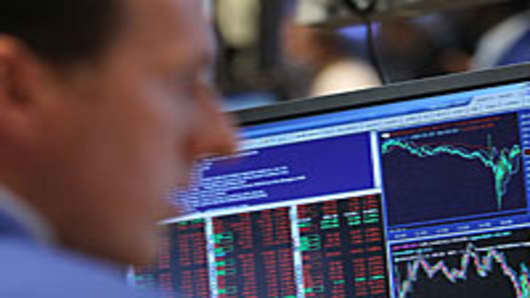With technical barriers continuing to give way and the May 6 "flash-crash" fluke looking like not so much of a fluke anymore, market watchers were left Thursday wondering how much worse things could get.
Forecasts varied substantially but few thought there was much to stand in the way of a further move down that would bring the major indexes officially into correction territory, or 10 percent off their most recent highs.
Standard & Poor's said the correction could total 15 percent by the time all is said and done, sending its benchmark S&P 500 to the 1035 range.
Others weren't quite so pessimistic, but worry seemed to be the word as a confluence of bad news proved a toxic mix that ended a powerful 14-month rally.
"I would have preferred a pullback that was a little more controlled and a little less news-oriented...something that was orderly and maybe just due to people taking profits and becoming a little more conservative," says Richard Sparks, senior analyst at Schaeffer's Investment Research in Cincinnati. "This feels a little out of control at this point."
Expressing a common sentiment among traders, Sparks says the S&P is likely to visit the 1050-1060 range before turning around.
Trading-floor technicians had been looking at 1100—the 200-day moving average—as a key support level for the S&P 500. The point has held up well during recent market dips off the rally that began from the brutal lows of March 2009.
But 1100 came and went Thursday as markets worried about whether European debt problemswould spread to the US and how new financial regulations would hurt banks.
It all harkened back to May 6, the day of the so-called "flash crash" when the Dow temporarily lost nearly 1,000 points. Written off by some as an anomaly—caused either by a trader mistake such as a "fat finger" and duress from electronic trading triggers—the averages in fact have fallen below the closing levels of that tumultuous day and threaten to drop even lower.
"The flash-crash kind of worried me from the standpoint that not only did they not know exactly why it happened, but if you don't know why it happened you can't prevent it from happening again," Sparks says.
Many traders see the market drop as a normal part of the process after such a relentless rally. Yet even among that group, the flash-crash represents a signature moment.
"Our first level of support should be that fat-finger low," says Todd Horwitz, a trader and chief strategist for the Adam Mesh Trading Group. "No matter what they blame it on, no matter what the story is, that's the footprint they put into the market."
In fact, Horwitz thinks the market could fall to the intraday lows of the flash crash—or 1065 for the S&P and 9869 for the Dow.
"The market overall is in a downtrend. The trend has changed from a couple weeks ago when we finally peaked out," Horwitz says. "Volatility is increasing here in the market. There's a lot more fear versus the complacency we had back then."
To be sure, not everyone was looking on the recent correction-level drop as bad thing.
After all, technicians for months have been saying the market was overbought and a true correction actually would be constructive. A leg lower, they reasoned, would be a good entry point for investors who missed the rally.
"It's not clearly indicating a 'sell' signal for us. It could easily be a 'buy' signal," says Dave Lutz, managing director of trading at Stifel Nicolaus in Baltimore. "Consolidation pullbacks make perfect sense so everybody can take a look back and re-evaluate the levels where we are and re-evaluate the macro picture."
But the market faces a slew of pressures—geopolitical and domestic events that are forcing technical levels.
"Mutual fund managers have virtually no cash—they're fully invested," says Rick Bensignor, chief market strategist at Execution Noble in New York. "In order to handle redemptions, that requires them to sell stock to raise cash. That selling is going to add more selling pressure to the market."
While technical levels will trigger automated electronic selling programs, Bensignor points out that fundamentals drive the sentiment that pushes the market to those technical points.
"There are real problems going on in the world right now," says Bensignor, who thinks the S&P is likely to hit 1060 but will plunge to 950 should it fail that test. "Technicals are a reflection of behavior and it's just trying to use charts to anticipate where the behavior is. My best guess is it's in the process of shifting areas, and it could fall swiftly."



